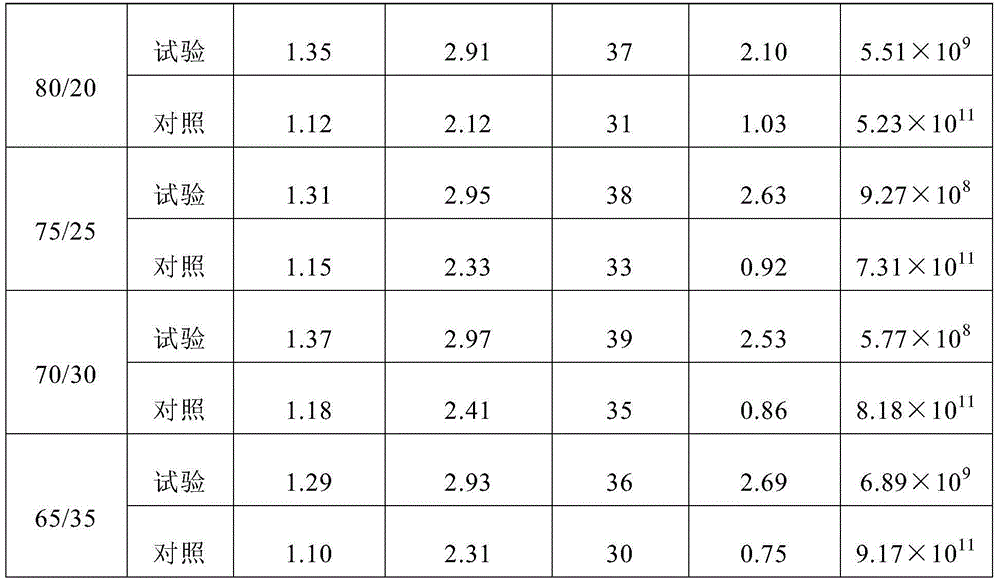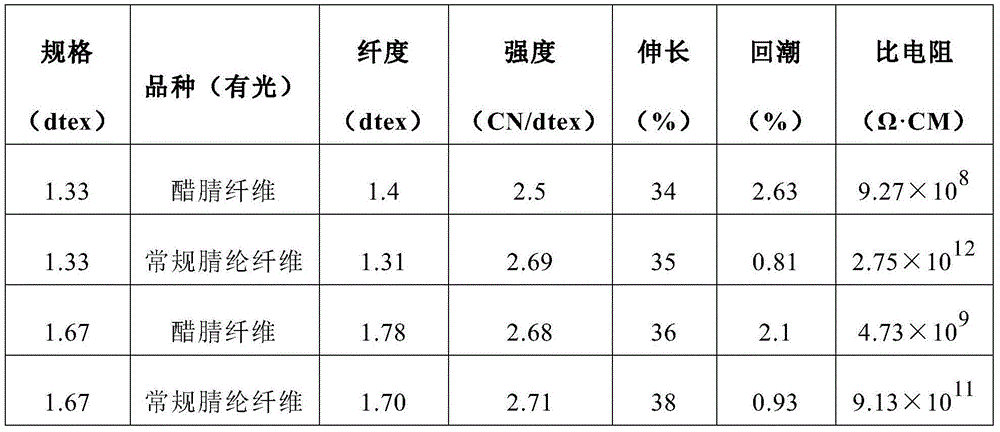Acetate fiber and preparation method thereof
A cellulose acetate and fiber technology, applied in the field of fiber materials, can solve the problems of poor hygroscopicity of acrylic fibers, low strength of pure acetate fibers, poor wearability, etc., and achieves the effects of good moisture regain, low strength improvement, and easy control.
- Summary
- Abstract
- Description
- Claims
- Application Information
AI Technical Summary
Problems solved by technology
Method used
Image
Examples
Embodiment 1
[0056] Embodiment 1, the preparation of acetonitrile fiber
[0057] 1) Polymer production: Mix 92wt% acrylonitrile and 8wt% vinyl acetate, adjust the mixed concentration to 30-40wt%, and continue at 58-62°C and pH 2.5-3.5 Carry out aqueous phase suspension polymerization reaction; the reacted polymer is terminated by chelation reaction, the unreacted monomer is removed by a stripper, and then the salt and water are removed by washing and filtering, and the powdery polymer is obtained by drying after granulation. Acrylonitrile;
[0058] 2) The sum of powdered polyacrylonitrile, cellulose acetate and solvent dimethylacetamide by mass of powdered polyacrylonitrile and cellulose acetate (85wt%: 15wt%) and dimethylacetamide by mass 20wt%: 80wt % ratio mixing, heating up to 80°C to completely dissolve polyacrylonitrile and cellulose acetate in the solvent dimethylacetamide, then cooling down to 70°C for filtration to obtain spinning dope;
[0059] 3) The spinning stock solution is...
Embodiment 2
[0060] Embodiment 2, the preparation of acetonitrile fiber
[0061] 1) Polymer production: Mix 94wt% acrylonitrile and 6wt% vinyl acetate, adjust the mixed concentration to 30-40wt%, and continue at 58-62°C and pH 2.5-3.5 Carry out aqueous phase suspension polymerization reaction; the reacted polymer is terminated by chelation reaction, the unreacted monomer is removed by a stripper, and then the salt and water are removed by washing and filtering, and the powdery polymer is obtained by drying after granulation. Acrylonitrile;
[0062] 2) Combine powdery polyacrylonitrile, cellulose acetate and solvent dimethylacetamide by mass 23wt%: 77wt of powdered polyacrylonitrile and cellulose acetate (80wt%: 20wt%) % ratio mixing, heating up to 80°C to completely dissolve polyacrylonitrile and cellulose acetate in the solvent dimethylacetamide, then cooling down to 70°C for filtration to obtain spinning dope;
[0063] 3) The spinning stock solution is then spun at a pressure of 0.7-0....
Embodiment 3
[0064] Embodiment 3, the preparation of acetonitrile fiber
[0065] 1) Polymer production: Mix 93wt% acrylonitrile and 7wt% vinyl acetate, adjust the mixed concentration to 30-40wt%, and continue at 58-62°C and pH 2.5-3.5 Carry out aqueous phase suspension polymerization reaction; the reacted polymer is terminated by chelation reaction, the unreacted monomer is removed by a stripper, and then the salt and water are removed by washing and filtering, and the powdery polymer is obtained by drying after granulation. Acrylonitrile;
[0066] 2) The sum of powdered polyacrylonitrile, cellulose acetate and solvent dimethylacetamide by weight of powdered polyacrylonitrile and cellulose acetate (75wt%: 25wt%) and dimethylacetamide by mass 25.5wt%: Mix at a ratio of 74.5 wt%, and heat up to 80°C to completely dissolve polyacrylonitrile and cellulose acetate in the solvent dimethylacetamide, then cool down to 70°C and filter to obtain a spinning stock solution;
[0067] 3) The spinning ...
PUM
| Property | Measurement | Unit |
|---|---|---|
| elongation | aaaaa | aaaaa |
Abstract
Description
Claims
Application Information
 Login to View More
Login to View More - R&D
- Intellectual Property
- Life Sciences
- Materials
- Tech Scout
- Unparalleled Data Quality
- Higher Quality Content
- 60% Fewer Hallucinations
Browse by: Latest US Patents, China's latest patents, Technical Efficacy Thesaurus, Application Domain, Technology Topic, Popular Technical Reports.
© 2025 PatSnap. All rights reserved.Legal|Privacy policy|Modern Slavery Act Transparency Statement|Sitemap|About US| Contact US: help@patsnap.com



